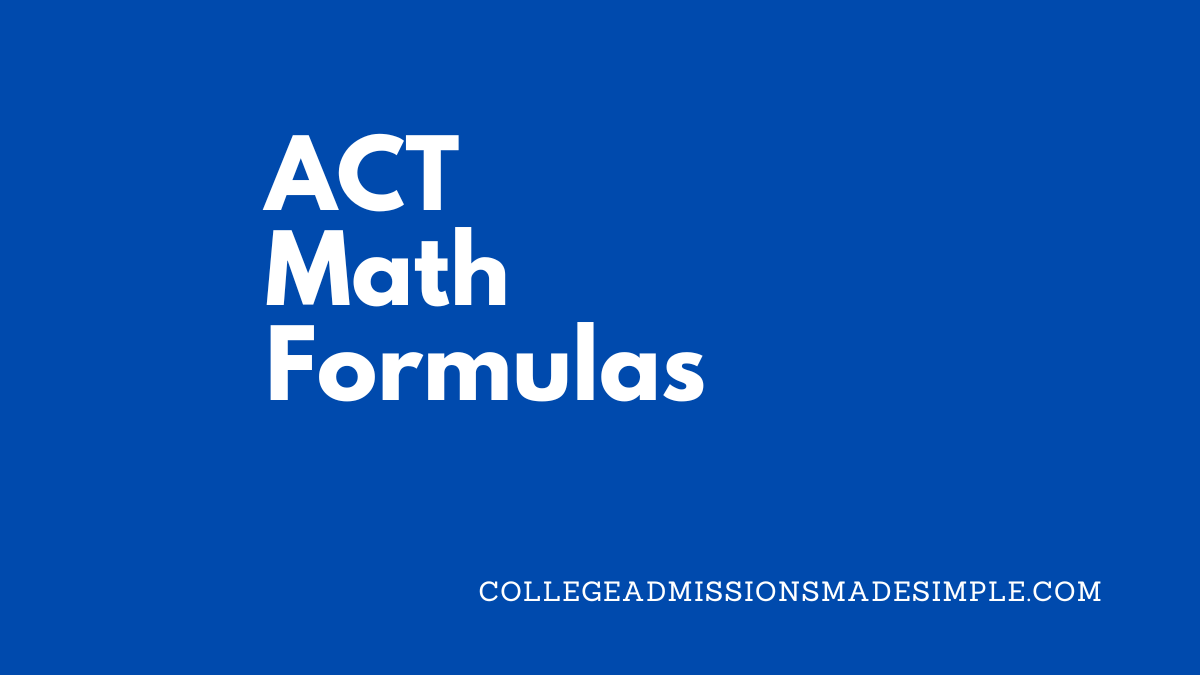What. math formulas should you know when you take the ACT? Well, we are glad you asked. Let’s take a look at some of the most commonly used formulas, how to memorize them, and then look at some example problems and how to solve them.
The math section of the ACT covers a range of topics, testing students on their mathematical knowledge and problem-solving abilities. The main math topics covered on the ACT test are Pre-Algebra/Arithmetic, Elementary Algebra, Intermediate Algebra, Coordinate Geometry, Plane Geometry, and Trigonometry. Here is a list of formulas you will need to know to succeed on the math section:
Arithmetic / Pre-Algebra
- Distance formula: Distance = Rate × Time
- Percentages: Part = Percent × Whole
- Average: Average = Sum of terms / Number of terms
Pre-Algebra
- Ratios and proportions: a/b = c/d
- Slope-intercept form: y = mx + b
- Point-slope form: y – y1 = m(x – x1)
Elementary Algebra
- Quadratic formula: x = [-b ± √(b²-4ac)] / 2a
- FOIL method: (a + b)(c + d) = ac + ad + bc + bd
- Factoring: ax² + bx + c = (px + q)(rx + s)
Intermediate Algebra
- Exponential growth/decay: y = a(1 ± r)^t
- Logarithm properties: log_a(b * c) = log_a(b) + log_a(c), log_a(b/c) = log_a(b) – log_a(c), log_a(b^c) = c * log_a(b)
- Distance formula in the coordinate plane: d = √[(x2 – x1)² + (y2 – y1)²]
- Coordinate Geometry
- Midpoint formula: M = [(x1 + x2)/2, (y1 + y2)/2]
- Slope formula: m = (y2 – y1) / (x2 – x1)
- Equation of a circle: (x – h)² + (y – k)² = r²
Plane Geometry
- Perimeter and area of basic shapes (rectangle, triangle, parallelogram, trapezoid, circle)
- Volume of 3D shapes (rectangular prism, cylinder, cone, sphere)
- Sum of interior angles of a polygon: (n – 2) × 180° (where n is the number of sides)
Trigonometry
- SOHCAHTOA: sin(θ) = opposite/hypotenuse, cos(θ) = adjacent/hypotenuse, tan(θ) = opposite/adjacent
- Pythagorean identity: sin^2(θ) + cos^2(θ) = 1
- Angle sum/difference identities: sin(A ± B) = sin(A)cos(B) ± cos(A)sin(B), cos(A ± B) = cos(A)cos(B) ∓ sin(A)sin(B)
How to Memorize These Formulas
The simplest method we have found to learn and memorize these formulas is to make 3×5 flashcards with the name on one side and the formula on the other. The second method is to actually use the formulas and practice, practice, practice. Here is the plan:
- Buy some 3×5 cards
- Put one formula on each card
- Read them through 5 times a night before you get ready for bed
- Do 5 to 10 practice math problems each night
- Repeat
ACT Math Section Example Problems
Here are some problems we have created that mimic those found on the ACT. You will find the answers and how to solve the problem below.
- A car travels at a constant speed of 40 mph for 2.5 hours. How far does it travel?
- If 4 pencils cost $1, how much do 12 pencils cost?
- Solve the quadratic equation x² – 5x + 6 = 0
- A population of bacteria doubles every 3 hours. If there are initially 100 bacteria, how many will there be after 9 hours?
- Find the midpoint of the line segment with endpoints A(3, 4) and B(7, 8).
- Find the perimeter and area of a rectangle with length 5 and width 3.
- In a right triangle, one leg measures 5, and the hypotenuse measures 13. Find the measure of the angle θ opposite the leg of length 5.
Answers
- Problem: A car travels at a constant speed of 40 mph for 2.5 hours. How far does it travel?
Solution: Distance = Rate × Time Distance = 40 mph × 2.5 hours Distance = 100 miles - Problem: If 4 pencils cost $1, how much do 12 pencils cost?
Solution: Set up the proportion: 4/$1 = 12/x Cross-multiply: 4x = 12 Solve for x: x = 3
Answer: 12 pencils cost $3. - Problem: Solve the quadratic equation x² – 5x + 6 = 0.
Solution: Apply the quadratic formula: x = [-b ± √(b² – 4ac)] / 2a x = [5 ± √(25 – 24)] / 2 x = [5 ± √1] / 2 x = [5 ± 1] / 2 x = 3, 2 (two possible solutions) - Problem: A population of bacteria doubles every 3 hours. If there are initially 100 bacteria, how many will there be after 9 hours?
Solution: Use the exponential growth formula: y = a(1 + r)^t y = 100(1 + 1)^3 y = 100(2)^3 y = 100(8) y = 800
Answer: There will be 800 bacteria after 9 hours. - Problem: Find the midpoint of the line segment with endpoints A(3, 4) and B(7, 8).
Solution: Apply the midpoint formula: M = [(x1 + x2)/2, (y1 + y2)/2] M = [(3 + 7)/2, (4 + 8)/2] M = [10/2, 12/2] M = (5, 6)
Answer: The midpoint is (5, 6). - Problem: Find the perimeter and area of a rectangle with length 5 and width 3.
Solution: Perimeter = 2 × (length + width) Perimeter = 2 × (5 + 3) Perimeter = 2 × 8 Perimeter = 16 Area = length × width Area = 5 × 3 Area = 15
Answer: The perimeter is 16 units, and the area is 15 square units. - Problem: In a right triangle, one leg measures 5, and the hypotenuse measures 13. Find the measure of the angle θ opposite the leg of length 5.
Solution: Use the sine function: sin(θ) = opposite/hypotenuse sin(θ) = 5/13 θ = arcsin(5/13) θ ≈ 22.6°
Answer: The angle θ is approximately 22.6°.

